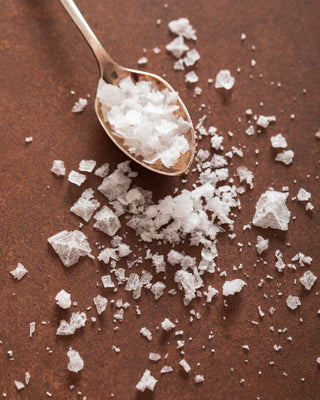

9-Course Spiel: Jing Gao of Fly By Jing
Posted by:
Jacobsen Salt Co.
Posted on:
Sep 14, 2022

In celebration of JSC's infused salt collab with Fly By Jing, read our latest Q&A with founder, Jing Gao. Learn how Fly By Jing came to be, the first thing Jing ever learned to cook, and what three Chinese condiments she suggests always stocking in your kitchen.
1. How did Fly By Jing come to be? Can you recall the moment that made you realize you needed to start this company?
I was running a supper club—back when those were a thing!—and it became very clear very quickly that my chili crisp, which was a key part of a lot of dishes, was something special. So Fly By Jing was not born of some notion of wanting to start a company; it happened because the recipe was right and people wanted to take it home.
2. Seeing that Fly By Jing was inspired by your hometown, Chengdu, China, how has family and culture shaped what Fly By Jing is today?
The FBJ tagline is “not traditional, but personal” and those four words capture so much of what building it all means to me personally and what we’re doing with the company more broadly. I returned to Chengdu as a young adult and the pathway to bond with my family was food, food, and more food.
3. What sets Fly By Jing’s chili crisp apart from other chili crisps out there?
Our chili crisp is the first all-natural chili crisp. It’s small-batch crafted in Chengdu and crafted with layers of premium ingredients that are native to Chengdu and can’t be found anywhere else, including the elusive Tribute Pepper. They give the chili crisp floral, tingly notes (and are so highly prized that they were offered as tribute to the emperor). They’re only grown in one small village and are painstakingly hand-picked — so they’re super rare and very special. When I launched Fly By Jing, I set out to introduce the Western palate to these highly specific flavors, and I think it’s one of the reasons the chili crisp has resonated with so many people.
4. In your own kitchen: what’s your most-used Fly By Jing product right now, and your favorite way to use it?
It’s so hard to choose just one, but our Tingly Sichuan Salt is actually what I’m using most right now. Sprinkling it on pineapple makes for the most refreshing summer snack.
5. Tribute Peppers and Erjingtiao Chilis are the two Sichuan ingredients in the Tingly Sichuan Salt. We’ll notice in salt making how certain environmental factors might create super subtle nuances in the final product (size of flake, difference between winter vs. summer salt, etc). Have you observed anything like this with the annual harvests of tribute peppers and erjingtiao chilis?
Definitely. Tribute peppers are from a village where the climate is very humid and the topography of it makes the flavors of the sichuan pepper from that area super strong and distinct. The fragrance, more natural oils, stronger citrus. The reason its called tribute pepper is because its from this specific plot of land.
6. If you had to recommend three Chinese condiments people should always stock in their kitchens, what would they be?
Doubanjiang, sichuan pepper, and black vinegar.
7. The first thing you ever learned to cook– what was it and who taught you?
Dumplings with my grandma!
8. What’s a seemingly underrated cooking ingredient or tool that’s been a game-changer for the way you prepare a dish at home (can be at any stage of the cooking process i.e prep or plating)?
Sichuan pepper! It can definitely seem intimidating to people who don’t cook with them, but even just throwing a handful of Tribute Peppers (gongjiao) into a long braise or stew will give the dish these really fragrant citrus notes and that signature Sichuan numbing sensation.
9. When I say “Sichuan” what’s the first thing that comes to mind?
Home. I was born in Sichuan Province, and, though my family moved around quite a bit, I returned to China in my mid-twenties. It was there that I embarked on this very personal journey of rediscovering my heritage, my voice, and subsequently developing my own expressions to Sichuan flavors.












